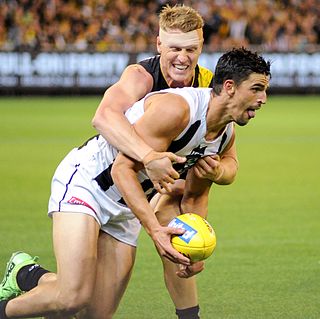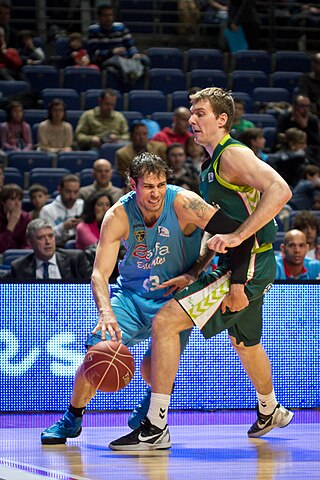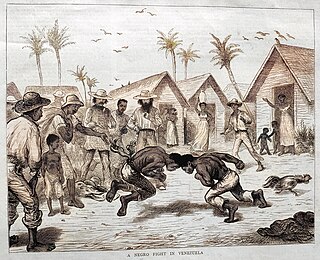Related Research Articles

Canadian football, or simply football, is a sport in Canada in which two teams of 12 players each compete on a field 110 yards (101 m) long and 65 yards (59 m) wide, attempting to advance a pointed oval-shaped ball into the opposing team's end zone.

Association football, more commonly known as football or soccer, is a team sport played between two teams of 11 players each, who primarily use their feet to propel a ball around a rectangular field called a pitch. The objective of the game is to score more goals than the opposing team by moving the ball beyond the goal line into a rectangular-framed goal defended by the opposing team. Traditionally, the game has been played over two 45-minute halves, for a total match time of 90 minutes. With an estimated 250 million players active in over 200 countries and territories, it is the world's most popular sport.

Most forms of football have a move known as a tackle. The primary purposes of tackling are to dispossess an opponent of the ball, to stop the player from gaining ground towards goal or to stop them from carrying out what they intend.

Field hockey is a team sport structured in standard hockey format, in which each team plays with 11 players in total, made up of 10 field players and a goalkeeper. Teams must move a hockey ball around a pitch by hitting it with a hockey stick towards the rival team's shooting circle and then into the goal. The match is won by the team that scores the most goals. Matches are played on grass, watered turf, artificial turf, or indoor boarded surface.

Ice hockey is a team sport played on ice skates, usually on an ice skating rink with lines and markings specific to the sport. It belongs to a family of sports called hockey. In ice hockey, two opposing teams use ice hockey sticks to control, advance, and shoot a closed, vulcanized, rubber disc called a "puck" into the other team's goal. Each goal is worth one point. The team which scores the most goals is declared the winner. In a formal game, each team has six skaters on the ice at a time, barring any penalties, one of whom is the goaltender. Ice hockey is a full contact sport, and is considered to be one of the more physically demanding team sports.

Gridiron football, also known as North American football, or in North America as simply football, is a family of football team sports primarily played in the United States and Canada. American football, which uses 11 players, is the form played in the United States and the best known form of gridiron football worldwide, while Canadian football, which uses 12 players, predominates in Canada. Other derivative varieties include arena football, flag football and amateur games such as touch and street football. Football is played at professional, collegiate, high school, semi-professional, and amateur levels.

A penalty in ice hockey is a punishment for an infringement of the rules. Most penalties are enforced by sending the offending player to a penalty box for a set number of minutes. During the penalty the player may not participate in play. Penalties are called and enforced by the referee, or in some cases, the linesman. The offending team may not replace the player on the ice, leaving them short-handed as opposed to full strength. When the opposing team is said to be on a power play, they will have one more player on the ice than the short-handed team. The short-handed team is said to be "on the penalty kill" until the penalty expires and the penalized player returns to play. While standards vary somewhat between leagues, most leagues recognize several common varieties of penalties, as well as common infractions.
Checking in ice hockey is any of a number of defensive techniques aimed at disrupting an opponent with possession of the puck or separating him from the puck entirely. Most types are not subject to penalty.

In basketball, a personal foul is a breach of the rules that concerns illegal personal contact with an opponent. It is the most common type of foul in basketball. A player fouls out on reaching a limit on personal fouls for the game and is disqualified from participation in the remainder of the game.

A headbutt is a targeted strike with the head, typically involving the use of robust parts of the headbutter's cranium as the area of impact. The most effective headbutts strike the most sensitive areas of an opponent, such as the nose, using the stronger bones in the forehead or the back of the skull.
Clipping is a penalty in the sport of ice hockey. It is generally recognized as hitting an opposing player at or below the other player's knees. Clipping should not be confused with hip checking, where one player hits an opponent with his hips, although occasionally a hip check will result in a clipping call. A player is generally assessed a minor penalty for clipping, unless an injury is caused, in which case a major penalty and a misconduct or game misconduct will result. It is one of the most rarely called penalties in the sport.

The horse-collar tackle is an American football maneuver in which a defender tackles another player by grabbing the back collar or the back-inside of an opponent's shoulder pads and pulling the ball carrier directly downward violently in order to pull his feet from underneath him. The technique is most closely associated with Pro Bowl safety Roy Williams.

The laws of Australian rules football were first defined by the Melbourne Football Club in 1859 and have been amended over the years as Australian rules football evolved into its modern form. The Australian Football Council (AFC), was formed in 1905 and became responsible for the laws, although individual leagues retained a wide discretion to vary them. Following the restructure of the Victorian Football League's competition as a national competition and the League's renaming to be the Australian Football League (AFL), since 1994, the rules for the game have been maintained by the AFL through its Commission and its Competition Committee.

Unsportsmanlike conduct is a foul or offense in many sports that violates the sport's generally accepted rules of sportsmanship and participant conduct. Examples include verbal abuse or taunting of an opponent or a game official, an excessive celebration following a significant play, or feigning injury. The official rules of many sports include a general provision whereby participants or an entire team may be penalized or otherwise sanctioned for unsportsmanlike conduct.
This is a list of common terms used in the sport of ice hockey along with the definitions of these terms.

High school football is gridiron football played by high school teams in the United States and Canada. It ranks among the most popular interscholastic sports in both countries, but its popularity is declining, partly due to risk of injury, particularly concussions. According to The Washington Post, between 2009 and 2019, participation in high school football declined by 9.1%. It is the basic level or step of tackle football.
This article describes the rules of judo. The main sections of the article describe the rules that apply to any situation in which judo is practiced, and those rules which apply only in judo competitions.

Shepherding is a tactic and skill in Australian rules football, a team sport. Shepherding is the act of legally pushing, bumping or blocking an opposing player from gaining possession of the ball or reaching the contest.

Association football was first codified in 1863 in England, although games that involved the kicking of a ball were evident considerably earlier. A large number of football-related terms have since emerged to describe various aspects of the sport and its culture.

Helmet-to-helmet collisions are occurrences in gridiron football when two players' football helmets make head-to-head contact with a high degree of force. Intentionally causing a helmet-to-helmet collision is a penalty in most football leagues, including many high school leagues.
References
- 1 2 This is the NFL's definition: Rule 3, Section 5
- ↑ See Rule 12, Section 2, Article 1 Archived 2013-11-09 at the Wayback Machine
- ↑ See Rule 7, Section 2, Article 5 Archived May 11, 2012, at the Wayback Machine
- ↑ Lorimer, Lawrence T.; Devaney, John (1977). The Football Book. Random House. p. 33.
- ↑ Savage, Jeff (August 2004). Play-by-Play Football. p. 19. ISBN 9780822514497.
- ↑ Saidoff, David C.; Apfel, Staurt C. (December 2004). The Healthy Body Handbook: A Total Guide to the Prevention and Treatment of. ISBN 9781934559451.
- ↑ Nelson, David M. (1994). The anatomy of a game: football, the rules, and the men who made the game. pp. 166–71. ISBN 9780874134551.